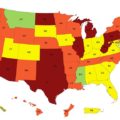Obesity in America: The Facts and the Consequences.
Obesity is defined as having a body mass index (BMI) that is greater than 30 kg/m2. The Body mass index is usually obtained by dividing a person’s weight by the square of the person’s height. Being obese differs from being overweight, they are two different concepts defined by different parameters.
A person is considered overweight when his or her body mass index falls within the range of 25–30 kg/m2. Obesity has become a major public health challenge in the United States largely due to changes in diet preferences and lifestyle patterns. According to the Center for Disease Control (CDC), 36.5% of adults in the United States are obese.
Obesity increases the risk of several chronic disease conditions
Recently available data also indicate that Louisiana has the highest rate of adult obesity in the United States at 36.2% while Colorado has the lowest at 20.2 %. Obesity increases the risk of several chronic disease conditions including diabetes type 2 cancer, hypertension, cardiovascular diseases and stroke.
Obesity places a huge financial burden
Obesity places a huge financial burden on personal and national coffers. The medical cost for obese individuals is about $ 1,429 higher than those of individuals with a normal BMI. As at 2008, the annual cost of obesity in the United States had already reached $147 billion and this is expected to exceed the current $ 210 billion if current trends are not halted.
Non-Hispanic blacks have the highest rate of obesity in the united states
According to the Journal of American Medicine, Non-Hispanic blacks have the highest rate of obesity in the united states at 48.1% this is closely followed by Hispanics with 42.5%, non-Hispanic whites have a rate of 34.5% while non-Hispanic Asians have the lowest rate of 1.7%. Available data also show that obesity rates are generally higher among middle-age adults aged 40-59 years.
Higher incomes are at higher risk of obesity
According to the National Center for Health Statistics (NCHS), those with higher incomes are at higher risk of obesity than those with lower income among non-Hispanic black and Mexican Americans. In addition, women with a college degree have been shown to be less likely to be obese as compared to less educated women but in men, no significant relationship was found between obesity and education.
80 % percent of adults in America are physically Inactive
A large percentage of adults in America are physically Inactive (80%). To be considered active an individual need to take at least 5000 steps daily. Available data indicate that, Mississippi has the highest rate of physically inactive individuals (36.8%) perhaps this explains why it also has the highest rate of diabetes in the United States.
According to a Youth Risk Behavior Surveillance report about
- 9 % of high school students are obese
- 0% of high school student overweight.
- Obesity rates in children ages 10 to 17 ranged from a low of 9.9 -21.7 % ((NSCH)
Until there is a deliberate and united effort to make significant changes regarding America’s insatiable appetite for junk food to the detriment of healthy choices coupled with other critical lifestyle adjustments, the impact of excess weight and its consequences will continue to be the burden on the United States and its population.Also Read: The Factors Fueling the Weight Epidemic in America
Frequently Asked Question
Copyright ©
Permission is hereby granted for the use of whole or parts of this article provided appropriate credit is given to www.publichealth.com.ng
Public Health Nigeria an Interdisciplinary public health movement focused on health education, advancing fair public health policies, promoting fitness, healthy diets, responsible behavior, community health and general well-being.







2 Comments